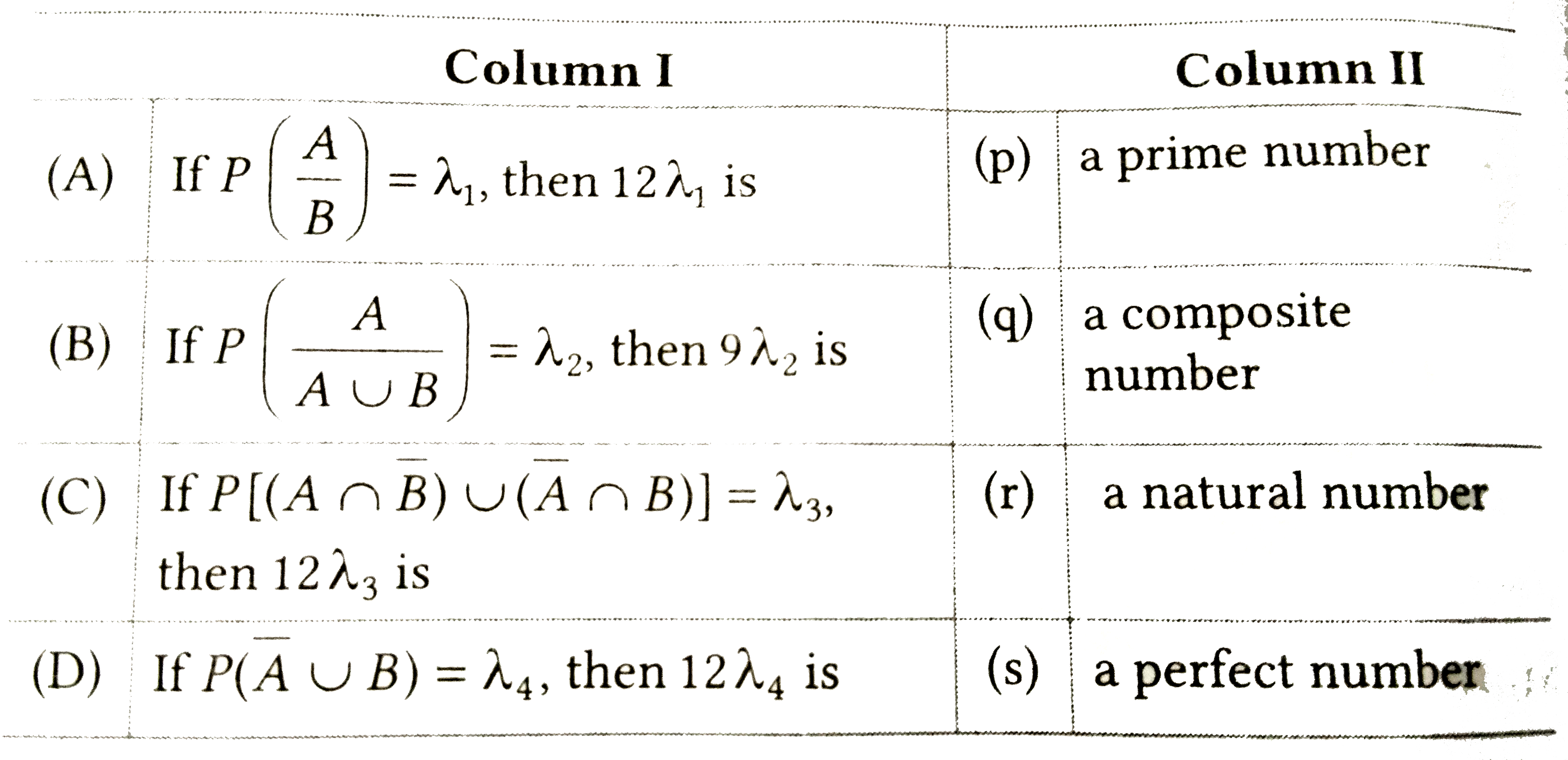If A and B are two events such that P(A)=12 and P(B)=23, then which of the following is incorrect ?
P(A∩B)≥23
P(A∩¯¯¯B)+≥13
16≤P(A∩B)≤12
16≤P(¯¯¯A∩B)≤12
The correct Answer is:B
To solve the problem, we need to analyze the probabilities of events A and B given the values of P(A)=12 and P(B)=23. We want to determine which of the provided statements about these probabilities is incorrect.
1. Identify the Given Probabilities:
- P(A)=12
- P(B)=23
2. Calculate the Maximum Possible Value of P(A∪B):
- The maximum value of P(A∪B) can be calculated using the formula:
P(A∪B)≤P(A)+P(B)
- Thus,
P(A∪B)≤12+23
- To add these fractions, we need a common denominator:
12=36,23=46
- Therefore,
P(A∪B)≤36+46=76
- Since probabilities cannot exceed 1, we conclude:
P(A∪B)≤1
3. Calculate the Minimum Possible Value of P(A∩B):
- The minimum value of P(A∩B) can be calculated using the formula:
P(A∩B)≥P(A)+P(B)−1
- Thus,
P(A∩B)≥12+23−1
- Again, converting to a common denominator:
P(A∩B)≥36+46−66=16
4. Verify the Ranges of P(A∪B) and P(A∩B):
- From the calculations:
- P(A∪B) can range from max(P(A),P(B)) to 1.
- P(A∩B) can range from 16 to min(P(A),P(B)).
5. Identify Incorrect Statements:
- We need to assess the provided options (not given in the question) to find which one contradicts the established bounds for P(A∪B) and P(A∩B).
Conclusion:
Based on the calculations, we have established that:
- P(A∪B)≤1
- P(A∩B)≥16
If any option states that P(A∪B)>1 or P(A∩B)<16, that would be incorrect.
- P(A)=12
- P(B)=23
- The maximum value of P(A∪B) can be calculated using the formula:
P(A∪B)≤P(A)+P(B)
- Thus,
P(A∪B)≤12+23
- To add these fractions, we need a common denominator:
12=36,23=46
- Therefore,
P(A∪B)≤36+46=76
- Since probabilities cannot exceed 1, we conclude:
P(A∪B)≤1
- The minimum value of P(A∩B) can be calculated using the formula:
P(A∩B)≥P(A)+P(B)−1
- Thus,
P(A∩B)≥12+23−1
- Again, converting to a common denominator:
P(A∩B)≥36+46−66=16
- From the calculations:
- P(A∪B) can range from max(P(A),P(B)) to 1.
- P(A∩B) can range from 16 to min(P(A),P(B)).
- We need to assess the provided options (not given in the question) to find which one contradicts the established bounds for P(A∪B) and P(A∩B).
Based on the calculations, we have established that:
- P(A∪B)≤1
- P(A∩B)≥16
Topper's Solved these Questions
- PROBABILITY BOOK - OBJECTIVE RD SHARMA ENGLISHCHAPTER - PROBABILITY EXERCISE - Section- II (Assertion -Reason Types MCQs)
15 Videos
- PROBABILITY BOOK - OBJECTIVE RD SHARMA ENGLISHCHAPTER - PROBABILITY EXERCISE - Section I - Mcqs
89 Videos
- PROBABILITY BOOK - OBJECTIVE RD SHARMA ENGLISHCHAPTER - PROBABILITY EXERCISE - Chapter Test
45 Videos
- PERMUTATIONS AND COMBINATIONSBOOK - OBJECTIVE RD SHARMA ENGLISHCHAPTER - PERMUTATIONS AND COMBINATIONSEXERCISE - Chapter Test
60 Videos
- QUADRATIC EXPRESSIONS AND EQUATIONS BOOK - OBJECTIVE RD SHARMA ENGLISHCHAPTER - QUADRATIC EXPRESSIONS AND EQUATIONS EXERCISE - Chapter Test
50 Videos
Similar Questions
Knowledge Check
If A and B are two events euch that P(A)≠0andP(B/A)=1 then
AA⊂BBB⊂ACB=ϕDnone of these
If A and B are two events such that P(A) = 3/4 and P(B) = 5/8, then
View SolutionIf A and B are two independent events, such that P(A)=13andP(B)=14.

View SolutionIf A and B are two events such that 2 P(A)=P(B)=513f∈dP(A∩B) .
View SolutionIf A and B are two events such that A⊂Band P(B)≠0,them which of the following is correct?
(A) P(A∣B)=P(B)P(A) (B) P(A∣B)<P(A) (C) P(A∣B)≥P(B) (D) none of these
View SolutionIf A and B are two independent events such that P (A) =1/2,P(B)=1/5, then
View SolutionIf A and B are two events such that 2P(A)=P(B)=513 and P(AB)=25, find P(A∪B).
View SolutionFor two events A and B, let P(A) = 35, P(B) = 23, then which of the following is correct?
View Solution
